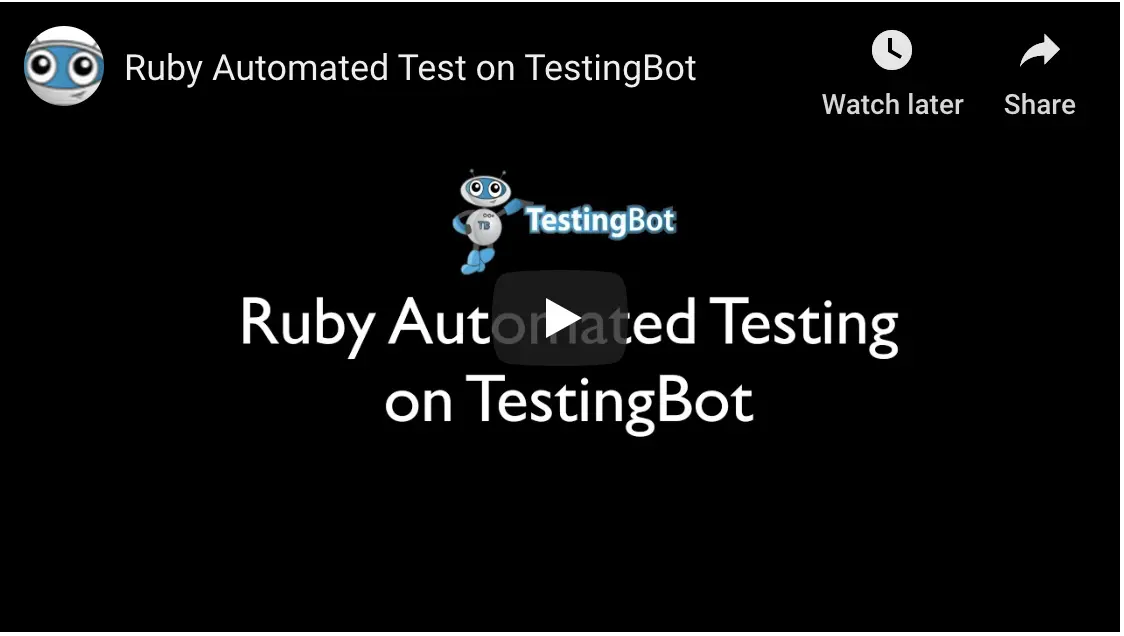Ruby Automated Testing
Let's start with making sure Ruby is available on your system.
For Windows:- You can download Ruby for Windows from RubyInstaller
- Run the installer and follow the setup wizard to install Ruby.
For Linux/macOS:
Download RVM and install Ruby:
curl -L https://get.rvm.io | bash -s stable --rubyInstallation

With TestingBot you can easily run your automated tests with any Ruby test framework, here's a simple example without any assertions:
gem install selenium-webdriver#!/usr/bin/env ruby
require 'rubygems'
require 'selenium-webdriver'
caps = Selenium::WebDriver::Remote::Capabilities.new
caps["browserName"] = "chrome"
caps["browserVersion"] = "latest"
caps["platformName"] = "WIN10"
caps["tb:name"] = "My First Test"
http_client = Selenium::WebDriver::Remote::Http::Default.new
http_client.read_timeout = 300 # Timeout for responses
http_client.open_timeout = 300 # Timeout for opening connections
driver = Selenium::WebDriver.for(
:remote,
:url => "https://API_KEY:API_SECRET@hub.testingbot.com/wd/hub",
:options => caps,
:http_client => http_client)
driver.navigate.to "https://www.google.com/ncr"
element = driver.find_element(:name, 'q')
element.send_keys "TestingBot"
element.submit
puts driver.title
driver.quitThis test will start the latest version of Chrome on Windows in our cloud, go to Google, and search for TestingBot. It will then output the title of the page.
Make sure to always stop your test (driver.quit), otherwise it will continue running, leading to a timeout.
Configuring capabilities
To run your existing tests on TestingBot, your tests will need to be configured to use the TestingBot remote machines. If the test was running on your local machine or network, you can simply change your existing test like this:
Before:driver = Selenium::WebDriver.for :chromedriver = Selenium::WebDriver.for(:remote,
:url => "https://API_KEY:API_SECRET@hub.testingbot.com/wd/hub",
:desired_capabilities => caps)Specify Browsers & Devices
To let TestingBot know on which browser/platform/device you want to run your test on, you need to specify the browsername, version, OS and other optional options in the capabilities field.
driver = Selenium::WebDriver.for(:remote,
:url => "https://API_KEY:API_SECRET@hub.testingbot.com/wd/hub",
:desired_capabilities => caps)To see how to do this, please select a combination of browser, version and platform in the drop-down menus below.
Testing Internal Websites
We've built TestingBot Tunnel, to provide you with a secure way to run tests against your staged/internal webapps.
Please see our TestingBot Tunnel documentation for more information about this easy to use tunneling solution.
The example below shows how to easily run a Ruby WebDriver test with our Tunnel:
1. Download our tunnel and start the tunnel:
java -jar testingbot-tunnel.jar key secret
2. Adjust your test: instead of pointing to 'hub.testingbot.com/wd/hub' like the example above - change it to point to your tunnel's IP address.
Assuming you run the tunnel on the same machine you run your tests, change to 'localhost:4445/wd/hub'. localhost is the machine running the tunnel, 4445 is the default port of the tunnel.
This way your test will go securely through the tunnel to TestingBot and back:
#!/usr/bin/env ruby
require 'rubygems'
require 'selenium-webdriver'
caps = Selenium::WebDriver::Remote::Capabilities.new
caps["browserName"] = "chrome"
caps["browserVersion"] = "latest"
caps["platformName"] = "WIN10"
caps["tb:name"] = "My First Test"
http_client = Selenium::WebDriver::Remote::Http::Default.new
http_client.read_timeout = 300 # Timeout for responses
http_client.open_timeout = 300 # Timeout for opening connections
client = Selenium::WebDriver::Remote::Http::Default.new
client.timeout = 120
driver = Selenium::WebDriver.for(
:remote,
:url => "http://API_KEY:API_SECRET@localhost:4445/wd/hub",
:options => caps,
:http_client => http_client
)
driver.navigate.to "https://www.google.com/ncr"
element = driver.find_element(:name, 'q')
element.send_keys "TestingBot"
element.submit
puts driver.title
driver.quitRun tests in Parallel
Parallel Testing means running the same test, or multiple tests, simultaneously. This greatly reduces your total testing time.
You can run the same tests on all different browser configurations or run different tests all on the same browser configuration.
TestingBot has a large grid of machines and browsers, which means you can use our service to do efficient parallel testing. It is one of the key features we provide to greatly cut down on your total testing time.
To get started, please see the examples on https://github.com/grosser/parallel_tests
Queuing
Every plan we provide comes with a limit of parallel tests.
If you exceed the number of parallel tests assigned to your account, TestingBot will queue the additional tests (for up to 6 minutes) and run the tests as soon as slots become available.
Mark tests as passed/failed
As TestingBot has no way to determine whether your test passed or failed (it is determined by your business logic), we offer a way to send the test status back to TestingBot. This is useful if you want to see if a test succeeded or failed from the TestingBot member area.
You can use our Ruby API client to report back test results.
api = TestingBot::Api.new(key, secret)
api.update_test(driver.session_id, { :name => new_name, :success => true })Other Ruby Framework examples
-
Capybara
Capybara is an integration testing tool for rack based web applications.
-
Cucumber
Cucumber is a Ruby based test tool for BDD.
-
RSpec
RSpec is a behavior-driven development (BDD) framework, inspired by JBehave.
-
Test::Unit
Test-Unit is a xUnit family unit testing framework for Ruby.
-
Minitest
Minimal (mostly drop-in) replacement for test-unit.
-
Watir
Watir, pronounced water, is an open-source (BSD) family of Ruby libraries for automating web browsers.